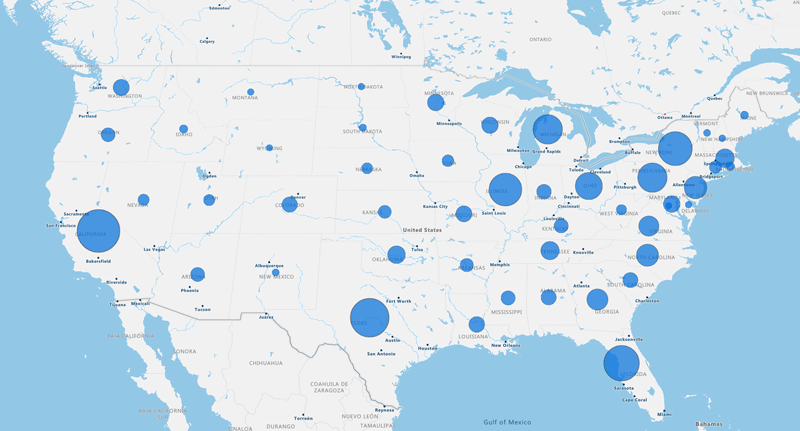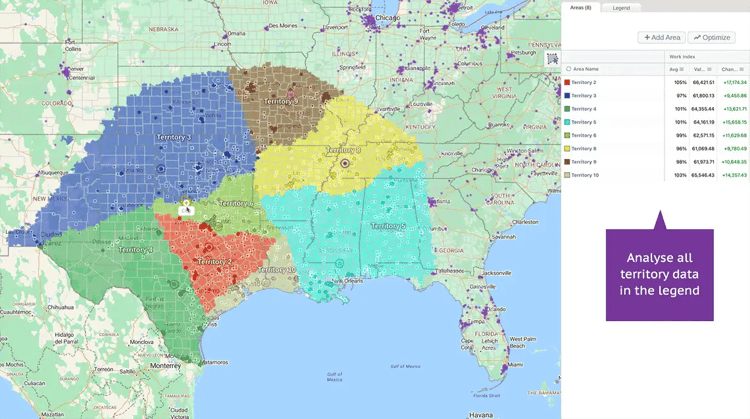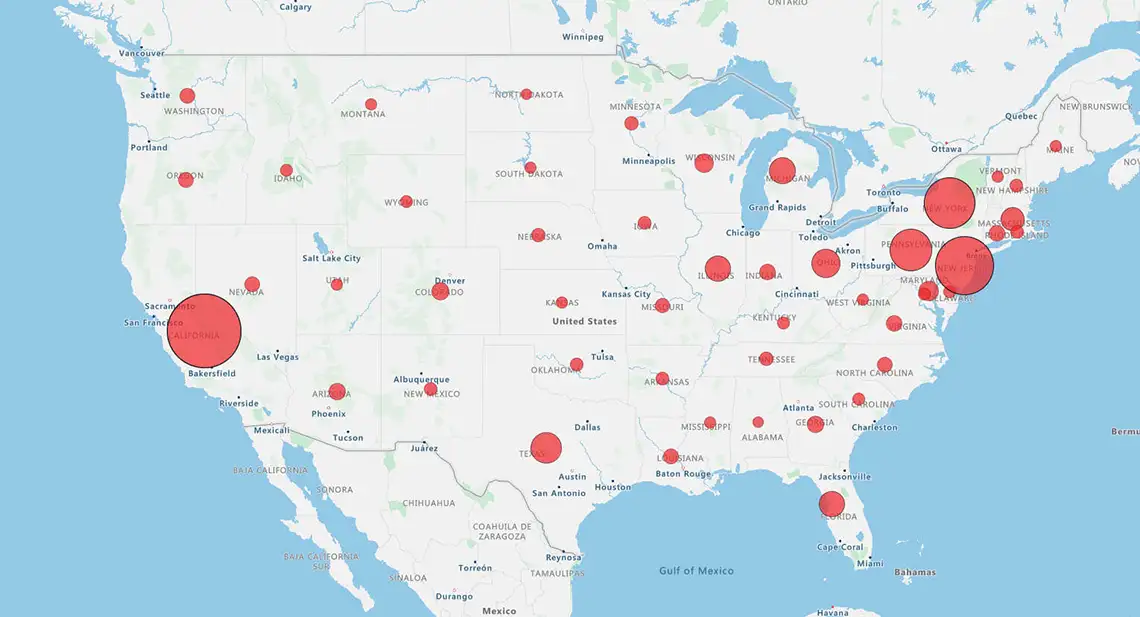Quick answer
Cluster mapping, or density mapping, is a powerful visualization tool that helps sales, marketing, and logistics teams identify hidden opportunities and optimize operations by revealing concentrations of data like customer locations.
Key takeaways:
- Visualize hidden patterns: See data points on a map to uncover relationships and insights not visible in a spreadsheet
- Optimize sales territories: Balance workloads and maximize performance by distributing leads and accounts more efficiently
- Discover new opportunities: Identify underserved areas for expansion or new market penetration
- Understand customer behavior: Gain regional insights to better segment audiences and tailor strategies
Cluster mapping is a powerful asset for sales, marketing, and logistics teams looking to extract deeper insights from geographic data. By visualizing spatial patterns and relationships, teams can uncover hidden opportunities, streamline operations, and connect more effectively with customers. These insights lead to smarter decisions and stronger business performance.
In this guide, we'll break down how cluster mapping works and how it can be applied across industries. You'll also learn how to build proximity-based clusters step by step using eSpatial's mapping software platform. Whether you're planning territories or spotting new growth areas, this guide will help you make location data work harder for your business.
What is a Cluster Map?
Cluster mapping, also known as bubble mapping or density mapping, uses geographic visualization to explore relationships between locations. A cluster map is a collection of plotted data points assigned a proportional symbol, like a circle or bubble, to represent a metric, such as population size or customer volume. This clustering technique shows concentrations of groups of similar entities.
By displaying clustered geographic data in an intuitive, interactive format, patterns that traditional data simply cannot convey can emerge. For example, a heat map showing sales activity clustered by zip code highlights new potential markets around population centers. With clustering software, users can visualize how neighborhoods, customers, or other entities relate based on location.

Low concentration
High concentration
Benefits of Cluster Maps For
Sales Territory Planning
Sales territory planning is no longer just about drawing boundaries; it's about uncovering insights that drive smarter, faster decisions. Cluster maps, powered by eSpatial's business mapping and insights tools, help sales leaders visualize patterns, spot opportunities, and align resources with precision. Below are seven key ways that illustrate what a cluster map is used for and how it turns complex data into actionable business value.
Visualize hidden data patterns
Cluster maps reveal trends and groupings in your data that spreadsheets can't. For sales teams, this means spotting dense customer areas or outliers that deserve more focus. The result is smarter targeting and resource allocation.
Segment your audience by location
Cluster maps group customers by location and shared traits like spending habits or product preferences. This reveals natural segments within your market. With these insights, you can tailor marketing and sales strategies to meet each group's specific needs.
Discover expansion opportunities
Cluster maps highlight underserved areas and market gaps. When you see customer clusters forming in regions with little coverage, it's a signal to assign reps or plan new locations. A cluster map can show that while one region is saturated with incumbent stores, an emerging residential area is underserved.
Optimize sales territories
Territory optimization tools within mapping software can help align accounts and maximize efficiency through scenario planning. Salespeople can quickly visualize account concentration and coverage imbalances across reps or regions. Cluster maps support smarter territory design that balances workloads and boosts performance.

Understand customer behavior by region
Mapping customer behaviors by region uncovers how location influences buying patterns. Urban vs. rural clusters, for example, can shape product focus, messaging, or channel mix. Cluster mapping detects when these groups fragment into new concentrations as residents relocate or interests diverge.
Reveal innovation opportunities
Cluster maps can expose dense, unmet demand outside your current footprint. These hotspots offer potential for new offerings or business models tailored to specific local needs. For example, a cluster map might reveal a dense group of customers in a growing suburb who aren't served by existing retail locations or whose buying patterns suggest unmet needs.
Support better decisions with Spatial context
When visualized spatially, patterns and priorities become clear. Cluster maps layer geographic context onto complex datasets, turning abstract numbers into actionable insights. Whether you're evaluating rep performance, customer density, or sales gaps, this spatial lens helps teams make faster, more confident decisions
How to Create a Cluster
Map for Sales Territories
Sales territory mapping software visualizes concentrations of data geographically. It summarizes your mapping project data based on location to reveal insights that may not be obvious from tables and charts alone. Cluster mapping allows sales managers to optimize territories, helps marketers analyze customer behavior, and assists operations teams in seeking efficiencies.
Gather geocoded sales and customer data
Gather address-level data for customers, sites, or other locations into a centralized spreadsheet. Ensure fields like address, city, state, and ZIP are formatted consistently. Clean any duplicate or missing entries.
Define clustering criteria
Understand why you want to create a cluster map and what question you want it to answer. Common objectives include identifying expansion opportunities, balancing sales and service team workloads, gauging supply and demand patterns, or analyzing economic clusters. Defining your objective upfront will help focus the analysis and ensure the map provides valuable insights.
Apply spatial clustering algorithms
Spatial clustering algorithms (like DBSCAN, K‑Means, and spatially constrained clustering) are data analysis techniques used to group nearby or similar geographic data points based on location and other attributes. These algorithms are embedded in eSpatial mapping software within an intuitive mapping interface, allowing businesses to harness advanced analytics without complex coding.
Adjust clusters for balance and practicality
Upload your dataset to the mapping platform. Select "cluster map" and choose the field to cluster by city or state. Adjust colors, cluster sizes, and labels as needed.
Assign territories and visualise the output
Create territory zones using ZIP codes, counties, custom shapes, or by importing definitions from spreadsheets or CRM systems. Auto-fill gaps and balance workloads by redistributing unassigned areas and calculating territory centers. Territories appear on dynamic maps with colour-coded boundaries and overlay options, and can be synced with CRMs or shared with stakeholders for real-time collaboration.
Review and refine regularly
Review the generated clustered map to spot trends, outliers, and geographic patterns indicated by cluster size and placement. Note any novel insights into expansion areas, customer behaviors, or supply chain efficiencies uncovered that could enhance your clustering project. Mapping software offers cluster search tools that let users interactively search clustered data, refine results, and gain deeper insights.
Real-world Examples
of Cluster Mapping
Here are some real-world examples of how eSpatial's easy-to-use cluster mapping tool is used across industries to drive smarter decisions:
- A retail chain uses cluster maps to visualize where high-spending customers are concentrated.
- A healthcare provider maps patient addresses and visit frequency.
- A B2B company uses cluster maps to analyze account density and sales rep coverage.
- A telecom company uses cluster mapping to visualize where service complaints are frequent, guiding targeted upgrades.
- A fast-food franchise identifies clusters of similar customer profiles in cities they don't yet serve.
Mapping Solutions For
Businesses From eSpatial
With comprehensive mapping software, teams gain insight into how best to support customer concentrations through more informed decisions. Customizable tools empower data-driven operations. These range from sales territory mapping to route optimization to marketing campaign targeting.
eSpatial's intuitive territory management software makes it easy to cluster, analyze, and act on geographic data within your existing workflows. It helps teams visualize relationships, optimize coverage, and make smarter, faster decisions. Choose an eSpatial pricing plan that fits your needs and unlock the full potential of location-based insights.


